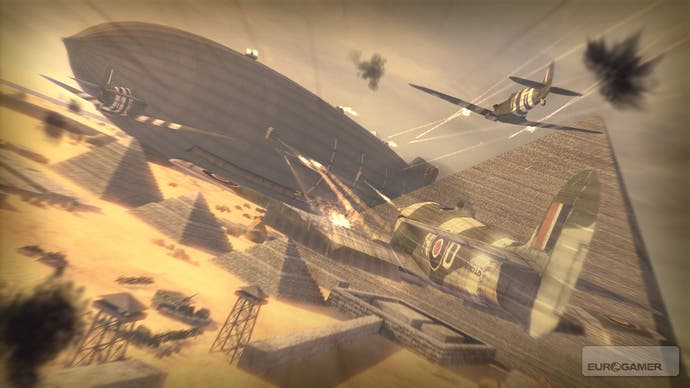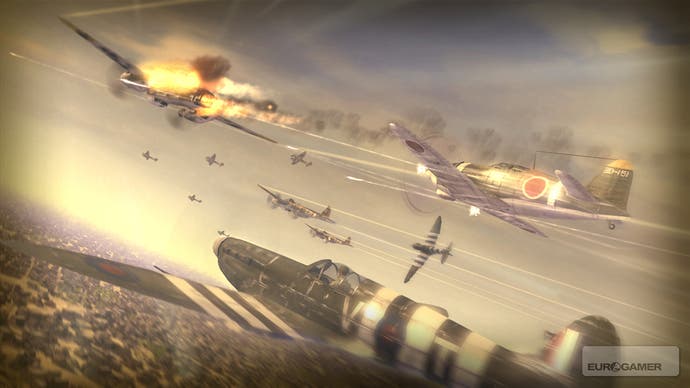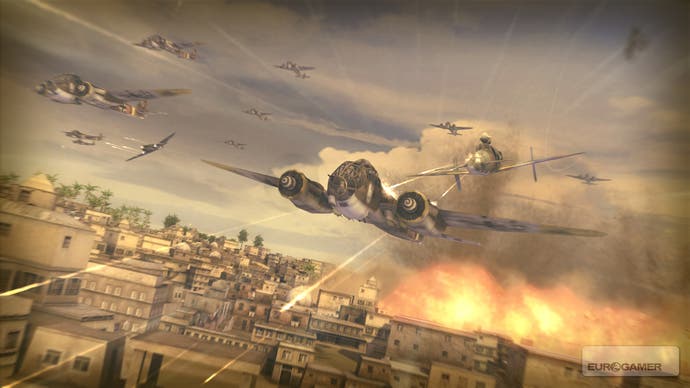Blazing Angels: Secret Missions of WWII
Kept secret for a damned good reason.
Do you, by any chance, recall LucasArts' excellent (and often criminally underrated) Xbox title, Secret Weapons Over Normandy?
We do. We recall it rather fondly, in fact - and that, in a nutshell, is the problem with Blazing Angels. It's not so much that this game doesn't hold a candle to Secret Weapons, whose style and concept it shamelessly apes; rather, it's that it's late on a weekday evening, all the candle shops are closed, and it doesn't have any matches to light a candle with even if it could fashion one out of earwax and string.
It would be disingenuous, however, to suggest that the only problem with Blazing Angels' second outing is that it can't live up to previous titles in this genre. Instead, we would submit that the real problem with Secret Missions of WWII is that it's a perfect example of taking a 5/10 game, slapping on a dash of next-gen graphical paint, and hoping nobody will notice that you haven't fixed any of the underlying problems that turned it into a 5/10 in the first place.
Seraphim Arson

The first Blazing Angels game was a pretty, nicely polished arcade combat flight game which suffered from having some of the most ludicrously poorly conceived stage design we'd seen in ages. Hard games are good; challenging games are good; badly designed games with difficulty curves like a six year old's drawing of a hedgehog, well, those are less than good. Blazing Angels fell firmly within that camp.
Upon picking up Secret Missions of WWII, it initially felt like the team at Ubisoft Romania had understood and acted upon the criticisms of the first game. A new progression system allows you to collect points during missions (either for kills or for collecting stunt tokens, which are often located in tricky positions such as under bridges) which are then spent on upgrading your plane or the abilities of your wingmen - that's a good start.
There's an in-cockpit view this time around, which is also a nice addition - although the cockpits are just large images blatted onto the screen, which make it hard to see what you're doing and will probably quickly get turned off. Still, it's there if you want it, and that's something.
Most importantly, though, the game treats you to a storyline which makes a huge departure from any kind of historical reality - filled with unlikely technology such as jet aircraft, homing missiles, Tesla coils and zeppelins twice the size of the Great Pyramid. Early missions tend to start out with fairly normal objectives, before becoming joyously ludicrous; later missions start out joyously ludicrous and go downhill from there.

All of which, you might think, suggests a game which is under no illusions about providing anything other than unadulterated fun. Unfortunately, you'd be wrong.
Instead, Secret Missions conspires to frustrate, annoy and generally upset you with a series of missions which manage to turn what should be a fun game about flying unlikely aircraft through historical wartime settings into an exercise in anger management. It feels for all the world like the designers of the four or five genuinely tooth-grindingly awful levels in the first Blazing Angels have been given free rein over this second game.
Take, for example, the fifth mission - the one whose notes in our game reviewing jotter indicate that it's where we would have given up completely, were it not for the fact that we had to review the damned game. Flying over enemy occupied Paris, you need to take down ten enemy planes without being spotted, which essentially means shooting down foes only in small specific areas of the airspace. Get it wrong by the tiniest margin, and flak guns will hammer your hitpoints.
Succeed at this singularly unenjoyable task, and your next job is to clear a path for a fleeing spy by knocking out watchtowers and armoured vehicles along the road. The road in question being a narrow road with three and four storey buildings along both sides, surrounded for miles around by other roads which look exactly the same... And successfully shooting some of the towers sends up a huge cloud of smoke which makes it impossible to work out where the roof level is. Kaboom. Time to retry.
Burnt Offering

Okay, so the Paris level is a particularly awful example - we accept that. However, our anger at the game isn't that it's simply dreadful. Instead, it's that Secret Missions actually shows moments of brilliance, sparks of sheer delight which show us just how good the game could have been, with the benefit of a little actual gameplay testing.
Indeed, just before the Paris level, you'll fly through wave after wave of bombers over Cairo, then shoot down waves of tanks which are being parachuted out of the skies, before finally taking on a giant zeppelin which unleashes waves of fighters from its belly to knock you out of the skies. It's epic, ridiculous, utterly fantastic stuff - but again, it's let down by some really uneven difficulty.
The first stage of the mission, for example, sees you tasked with scoring 1800 prestige points by knocking out enemy bombers. It's a straightforward demand, but it takes quite a while to rack up those points, even with the assistance of three wingmen. However, the game doesn't deign to give you a checkpoint at any point during this effort - so you'll almost certainly be retrying several times.
Then later in the level, you'll find that you need to shoot into the fighter bays of the zeppelin to take down the gigantic beastie - but after lining up carefully for the shot, you'll discover that the actual area which takes damage is tiny, badly marked out, and generally confusing. Minor niggles? Yes, absolutely - but sadly symptomatic of a general lack of care for the player experience, which mars the best levels and bubbles over into outright frustration on the weaker ones.

In spite of this, it's impossible to deny that Secret Missions is a better game than its predecessor. The graphics are truly fantastic this time around, with bustling city-scapes stretching off for miles into the distance, while superb levels of detail have been lavished on the planes themselves. The focus on imaginative "prototype" craft has allowed the team to cut loose on later stages, giving the player plenty of fun toys to try out. The impact of this is especially noticed in the vastly improved multiplayer mode, with tools such as the Tesla Coils helping to break up the somewhat monotonous dogfights of the previous title.
When push comes to shove, however, the work the team has put into improving the game tends to throw the continued weak level design into even starker relief. If you're a huge fan of arcade-style combat flight games and desperately need something new to sate your appetite, you may well find that Blazing Angels is worth persevering with. However, "persevering" is a key word - and despite the game's best efforts, the majority of players will simply find that the effort, patience and anger management skills being demanded of them are vastly disproportionate to the rewards on offer.


